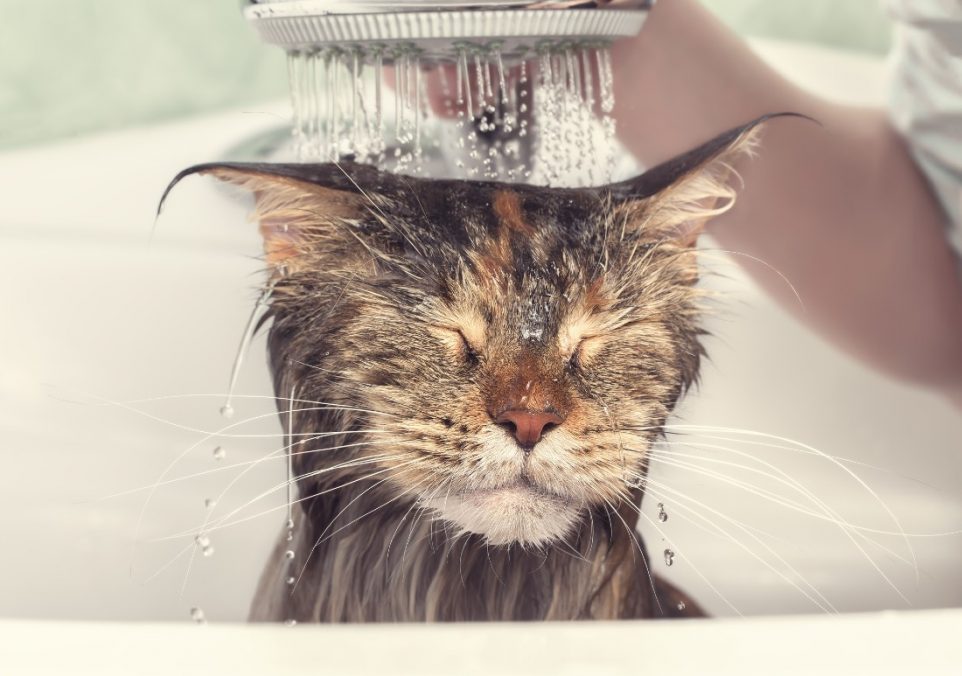Cat Bath Time: How To Bathe a Cat Safely

Cats are renowned for their meticulous self-grooming habits, making the idea of bathing them seem unnecessary. There are times when a cat bath becomes essential, such as when they encounter something sticky, dirt, or come into contact with harmful substances. If they’re unable to groom themselves due to medical conditions, bathing is necessary as well. Bathing a cat might be met with resistance, but with the right approach and preparation, it can be a stress-free experience for both you and your feline companion. This blog will provide you with a step-by-step guide on how to bathe a cat safely, ensuring that your furry friend remains clean and healthy.
Prepare the Environment
Before starting the bathing process, set up the bathroom to create a comfortable and safe environment. Place a rubber mat on the floor of the tub or sink to prevent slipping. Fill the tub with a few inches of lukewarm water and keep all the necessary supplies, such as cat-friendly shampoo, towels, and a gentle sprayer or container for rinsing, within arm’s reach.
Gather Supplies
Choose a shampoo specifically formulated for cats to avoid skin irritation. It’s important to have towels on hand to quickly dry your cat after the bath. Additionally, have a gentle, detachable sprayer or a container for rinsing. Cats are sensitive to water pressure, so a calm, controlled flow is essential.
Brush Before Bathing
Use an appropriate cat brush to brush your cat’s fur before the bath to remove any tangles or mats. This will make the bathing process easier and prevent further matting due to water exposure. A cat with fewer tangles is likely to be more cooperative during bath time.
Introduce Your Cat to Water
Cats are naturally cautious about water, so introduce them to the bathing area before the actual bath. Allow them to explore and sniff around, helping them become familiar with the surroundings.
Stay Calm and Patient
Approach your cat with a calm demeanor. Speak in soothing tones and gently place them in the water. Use one hand to support their body while the other hand wets them with water. Start from the back, avoiding their head and face.
Apply Shampoo Carefully
Apply a small amount of cat shampoo and gently lather their fur, being mindful of their sensitive areas. Avoid getting shampoo in their eyes, ears, and mouth. If your cat’s face needs cleaning, use a damp cloth to wipe it down.
Rinse Thoroughly
Rinsing is crucial to ensure that no shampoo residue remains on your cat’s skin, which could lead to irritation. Use the gentle sprayer or container to rinse your cat’s fur thoroughly. Make sure to remove all traces of shampoo.
Dry and Comfort
Gently wrap your cat in a soft towel and pat them dry. If your cat is comfortable with the noise, you can use a hairdryer on the lowest setting to speed up the drying process. Make sure the temperature is comfortable for your cat.
Offer Rewards and Praise
Once the bath is over, reward your cat with treats and praise for their cooperation. Positive reinforcement will help them associate bath time with positive experiences.
Conclusion
While bathing a cat may not be a routine chore, it’s an essential skill for every cat owner to have. With patience, preparation, and a gentle touch, you can safely bathe your cat when necessary, ensuring their hygiene and overall well-being. Remember, a calm and positive approach will go a long way in making bath time a stress-free event for both you and your feline friend.
Your Pet’s Best Interest, Always
At Pet Institute, we take pet care seriously. We're dedicated to transparency, impartiality, and the well-being of your pets in every article, review, and recommendation we provide. Our unwavering commitment to these principles ensures that you, our valued reader, always receive reliable and unbiased information. Let us be your trusted guide in the world of pet care and companionship.